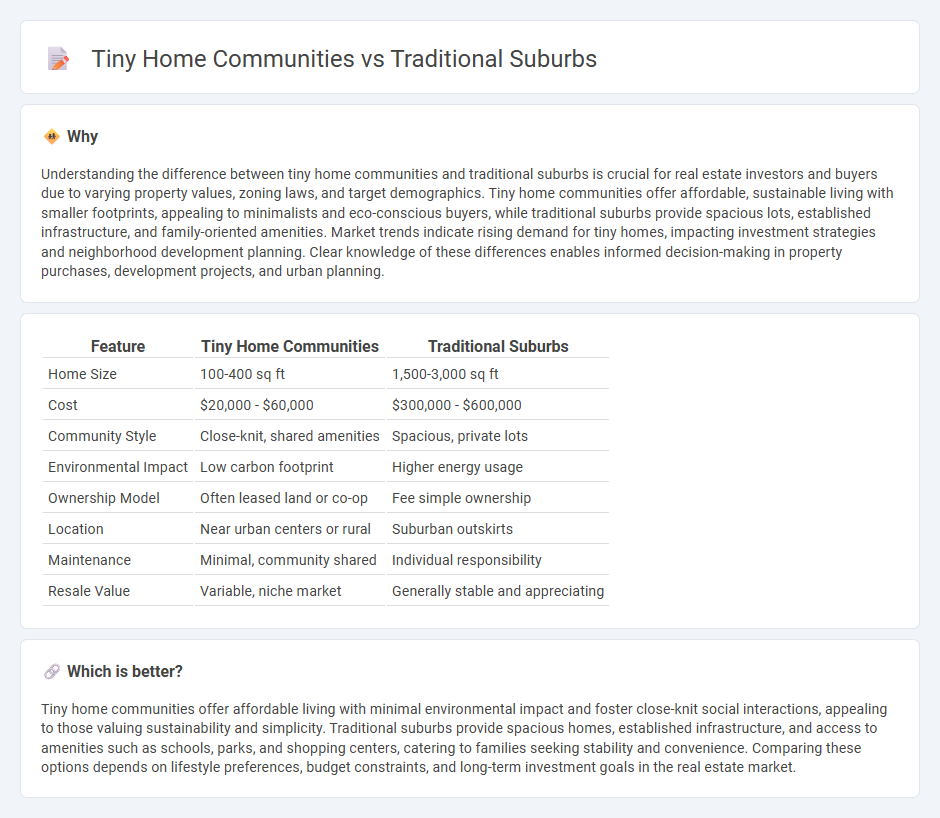
Tiny home communities offer affordable, eco-friendly living spaces designed for minimalist lifestyles, contrasting with traditional suburbs known for larger homes and extensive amenities on spacious lots. These communities focus on sustainability, reduced maintenance costs, and fostering close-knit neighborhoods, while suburbs prioritize privacy, larger family-oriented properties, and established infrastructure. Explore the advantages and challenges of both housing options to determine the best fit for your lifestyle and investment goals.
Why it is important
Understanding the difference between tiny home communities and traditional suburbs is crucial for real estate investors and buyers due to varying property values, zoning laws, and target demographics. Tiny home communities offer affordable, sustainable living with smaller footprints, appealing to minimalists and eco-conscious buyers, while traditional suburbs provide spacious lots, established infrastructure, and family-oriented amenities. Market trends indicate rising demand for tiny homes, impacting investment strategies and neighborhood development planning. Clear knowledge of these differences enables informed decision-making in property purchases, development projects, and urban planning.
Comparison Table
| Feature | Tiny Home Communities | Traditional Suburbs |
|---|---|---|
| Home Size | 100-400 sq ft | 1,500-3,000 sq ft |
| Cost | $20,000 - $60,000 | $300,000 - $600,000 |
| Community Style | Close-knit, shared amenities | Spacious, private lots |
| Environmental Impact | Low carbon footprint | Higher energy usage |
| Ownership Model | Often leased land or co-op | Fee simple ownership |
| Location | Near urban centers or rural | Suburban outskirts |
| Maintenance | Minimal, community shared | Individual responsibility |
| Resale Value | Variable, niche market | Generally stable and appreciating |
Which is better?
Tiny home communities offer affordable living with minimal environmental impact and foster close-knit social interactions, appealing to those valuing sustainability and simplicity. Traditional suburbs provide spacious homes, established infrastructure, and access to amenities such as schools, parks, and shopping centers, catering to families seeking stability and convenience. Comparing these options depends on lifestyle preferences, budget constraints, and long-term investment goals in the real estate market.
Connection
Tiny home communities and traditional suburbs intersect through shared goals of community living, affordable housing, and sustainable development. Both models address housing demand by optimizing land use and fostering neighborhood engagement while differing in scale and density. Real estate trends show increasing interest in integrating tiny homes within suburban settings to diversify housing options and support eco-friendly lifestyles.
Key Terms
Zoning Regulations
Traditional suburbs are governed by strict zoning regulations that often dictate minimum lot sizes, single-family housing, and extensive setbacks, limiting housing density and diversity. Tiny home communities face challenges navigating these regulations, as many zoning codes do not recognize tiny homes as permanent residences, complicating legal placement and community development. Explore how evolving zoning policies are shaping the future of affordable, sustainable living solutions.
Land Use Density
Traditional suburbs feature lower land use density characterized by single-family homes on large lots, leading to urban sprawl and increased infrastructure costs. Tiny home communities maximize land use density by clustering compact dwellings on smaller plots, promoting efficient resource use and sustainable living. Explore more about how land use density impacts urban planning and housing affordability.
Infrastructure Costs
Traditional suburbs often demand extensive infrastructure investments including roads, sewage systems, water supply, and electricity grids, significantly increasing development costs. Tiny home communities leverage compact designs that minimize the need for extensive infrastructure, resulting in lowered expenses for utilities and maintenance. Explore how these differences impact long-term affordability and sustainability in residential planning.
Source and External Links
The Suburbs - AMERICAN HERITAGE - Traditional suburbs often developed as streetcar suburbs featuring small single-family and multi-family houses on tiny lots, with minimal lawns and limited commercial nodes, forming extensions from city centers along trolley lines in the late 19th and early 20th centuries.
The Earliest Roots of the Suburban Experiment - Strong Towns - Early traditional suburbs were walkable and connected to the urban street grid, contained mixed housing sizes and styles, and prioritized accessibility and community integration over exclusivity and large lot sizes.
Suburb - Wikipedia - Traditional suburbs emerged in the 19th century around major urban centers, facilitated by rail and public transit, allowing residents to live outside overcrowded cities but commute in for work, with early examples including ribbon developments and estates around London.
 dowidth.com
dowidth.com